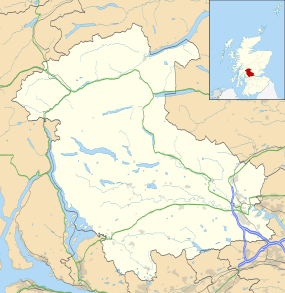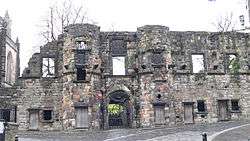Mar's Wark
| Mar's Wark | |
|---|---|
|
East façade of Mar's Wark at the head of Broad Street | |
| Location | St John Street, Stirling, Scotland |
| Coordinates | 56°07′16″N 3°56′39″W / 56.1211°N 3.9441°WCoordinates: 56°07′16″N 3°56′39″W / 56.1211°N 3.9441°W |
| Built | 1572 |
| Built for | John Erskine, Earl of Mar |
Listed Building – Category A | |
| Designated | 4 November 1965 |
| Reference no. | 41348 |
| Designated | 1999 |
| Reference no. | 90289 |
 Location of Mar's Wark in Stirling council area | |
Mar's Wark is a ruined building in Stirling built 1570–1572 by John Erskine, Regent of Scotland and Earl of Mar, and now in the care of Historic Scotland. Mar intended the building for the principal residence of the Erskine family in Stirling, whose chief had become hereditary keeper of the nearby royal Stirling Castle where the princes of Scotland were schooled. Wark is a Scots language word for work, and here it means building. The house is also called "Mar's Lodging."
Description
The building fronts the kirk yard of the Holy Rude Church and sits at the head of the processional route to Stirling Castle above the town's tollbooth. The windowless front façade survives lacking its upper storey, access is possible to the first floor. The basement vaults have doors and windows to the street and may have been intended for shops.
The façade is nearly symmetrical around a gatehouse frontispiece with two polygonal towers. Liberal carved stone decoration is based on European print-sources or decorative arts with royal and Erskine heraldry, and wry inscriptions. A motif of the letter "A" with the earl's coronet points to a variant version of the family name, as "Areskine," or possibly the initial of Mar's countess, Annabella Murray. Traditionally it has been alleged that the carvings include stones re-cycled from Cambuskenneth Abbey.
The general articulation and architectural mouldings closely reflect royal buildings, especially the palace at Stirling Castle. The Earl of Mar may well have called upon the skills of the royal Master of Work to the Crown of Scotland of the time, William MacDowall.[1]
The Wark is now protected by the Scottish Government as a category A-listed building,[2] and as a scheduled monument.[3]
Inscriptions
The middle Scots inscriptions carved on the gatehouse centrepiece refer to the onlooker's appreciation of the architecture and the eminence of the Regent himself in the building's own voice:
South tower
I pray all luikaris on this luging
With gentile E to gif thair juging
I pray all lookers on this lodging,
With gentle eye to give their judging.
North tower
The moir I stand on oppin hitht
My faultis moir subject ar to sitht
The more I stand on open height,
My faults more subject are to sight.
(As I am so prominent, so my faults are more obvious)
Internal (exit) arch
Esspy speik furth and spair nocht
Considder veil I cair notht
See, speak forth and spare not (or possibly; question not),
Consider well, I care not.[4]
History
It is often said that the building was never finished, but there is little evidence for this, although it was probably unfinished at the death of Regent Mar in October 1572. It seems from the records of Stirling burgh that Countess Annabella continued to use the building. As the lodging commands Broad Street and the town it was later used to mount artillery during civil unrest.
References
- ↑ Miles Glendinning, Ranald MacInnes, Aonghus MacKechnie, A History of Scottish Architure, EUP, (1996), pp.60-61.
- ↑ "Mar Place, Mar's Wark: Listed Building Report". Historic Scotland. Retrieved 19 December 2011.
- ↑ "Stirling, Mar's Wark, uncompleted residence". Historic Scotland. Retrieved 19 December 2011.
- ↑ Fleming, J. S., (1905), 167.
Further reading
- Chris Tabraham, Argyll's Lodging & Mar's Wark Historic Scotland (2002). ISBN 1-903570-40-9.
- Fleming, J. S., 'Regent Mar's Ludging,' in PSAS, (January 1905), pp.153-172 line drawings of sculpture and details of inscriptions.
External links
-
 Media related to Mar's Wark at Wikimedia Commons
Media related to Mar's Wark at Wikimedia Commons - Mar's Wark – site information from Historic Environment Scotland
- Mar's Wark, Scotland's Places
